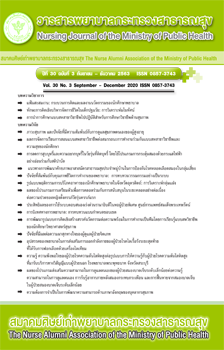Implementing of Interprofessional Education into Health Professional Education
Main Article Content
Abstract
Nowadays, healthcare providers of all disciplines are faced with complexity of health system. Solo professions cannot response to this current situation. Healthcare provider need to collaborate with other professions, local sector, and community members. Therefore, the preparation of students to have competencies in knowledge, skills, and attitudes, in order to be able to work collaboratively is crucial. Human resource development transform from the current curriculum framework to be competency-based training. This is done by focusing on the outcomes of education, designing interactive activities between instructors and students from other disciplines, and conducting a systematical evaluation to achieve desirable competencies. This article presents the definition of interprofessional education (IPE), the significance of IPE, learning outcome of IPE, the steps of introducing IPE in practice, and the recommendations in the implementation of IPE. A goal is to be able to demonstrate that the graduate student is able to mobilize knowledge, engage critical thinking, and conduct themselves in an ethical manner to work as a healthcare team based on the concept of patient and population-centered to response on complexity of healthcare system and disruptive technology effectively.
Article Details
บทความและรายงานวิจัยในวารสารพยาบาลกระทรวงสาธารณสุข เป็นความคิดเห็นของ ผู้เขียน มิใช่ของคณะผู้จัดทำ และมิใช่ความรับผิดชอบของสมาคมศิษย์เก่าพยาบาลกระทรวงสาธารณสุข ซึ่งสามารถนำไปอ้างอิงได้
References
2. World Health Organization. WHO Director-General’s opening remarks at the media briefing on COVID-19 11 March 2020 [internet]. [cited 2020 April 10]. Available from: https://www.who.int/dg/speeches/detail/who-director-general-s-opening-remarks-at-the-media-briefing-on-covid-19---11-march-2020.
3. Frenk J, Chen L, Bhutta ZA, Cohen J, Crisp N, Evans T, et al. Health professionals for a new century: transforming education to strengthen health systems in an interdependent world. Lancet.2010;376:1923-58.
4. World Health Organization. Framework for action on interprofessional education and collaborative practice. Geneva: World Health Organization; 2010.
5. Chuenkongkaew W. The guidance on interprofessional education. nd, editor. Bangkok: P.A. Living;2013. (in Thai).
6. Roslan NS, Yusoff MSD, Rahim AFA, Hussin ZAM. Together we stand, divided we fall: Interprofessional collaborative practice competencies from Malaysian medical professionals’ perspectives. Journal of Taibah University Medical Sciences 2016;11(6):533-40.
7. Reeves S, Perrier L, Goldman J, Freeth D, Zwarenstein M. Interprofessional education: effects on professional practice and healthcare outcomes (update). Cochrane Database Systematic Review. 2013;28(3).
8. Illingworth P, Chelvanayagam S. Benefits of interprofessional education in health care. British journal of nursing.2007;16(2):121-4.
9. Bridges DR, Davidson RA, Odegard PS, Maki IV, Tomkowiak J. Interprofessional collaboration: three best practice models of interprofessional education. Medical Education. 2011;16. 10.3402/meo.v16i0.6035. https://doi.org/10.3402/meo.v16i0.6035.
10. Kennedy D, Hyland A, Ryan N. Learning outcomes and competences 2009 [internet]. 2020 [cited 10 April 2020]. Available from: https://donstu.ru/en/Tuning%20Center/Learning%20Outcomes%20and%20 Competences.pdf
11. Sethasathien SA. Model of Interprofessional education (IPE) in department of physical medicine and rehabilitation, Udonthani Hospital. Thai Rehabilitation Medicine 2015;25(2):65-70. (in Thai).
12. Tanglakmankhong K, Khammathit A, Thammawongsa N, Ardpara A. The effectiveness of the nursing innovation course, using transprofessional education approach on readiness for transprofessional skill and the 21st Century Skill. The Southern College Network Journal of Nursing and Public Health 2019;6(2):126-39. (in Thai).
13. Freeth D, Hammick M, Reeves S, Koppel I, Barr H. Effective interprofessional education: development, delivery & evaluation. Oxford, UK: Blackwell; 2005.
14. Wilhelmsson M, Pelling S, Uhlin L, Owe Dahlgren L, Faresjö T, Forslund K. How to think about interprofessional competence: a metacognitive model. Journal of Interprofessional Care 2012(26):2.
15. Anderson LW, Krathwohl DR, Airasian PW, et al. A taxonomy for learning, teaching, and assessing: a revision of Bloom’s Taxonomy of educational objectives. Abridged Edition. New York: Longman; 2001:302.
16. Interprofessional Education Collaborative. Core competencies for interprofessional collaborative practice: 2016 update. Washington, DC: Interprofessional Education Collaborative;2016.
17. El-Awaisi A, Anderson E, Barr H, Wilby KJ, Wilbur K, Bainbridge L. Important steps for introducing interprofessional education into health professional education. Journal of Taibah University Medical Sciences. 2016;11(6):546-51.
18. Clark KM. Interprofessional education and collaborative practice: are we there yet? Journal of Lung Health and Diseases 2018;2(4):1-5.

